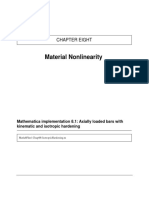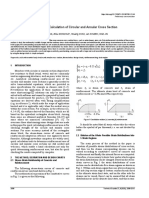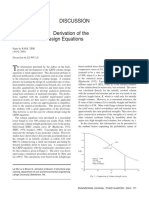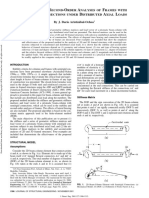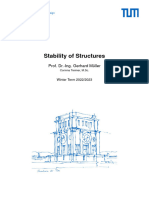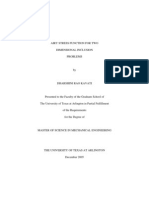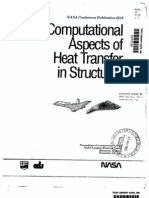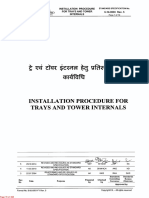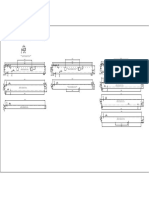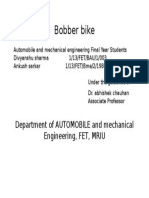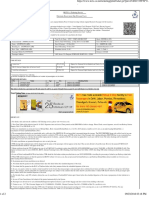100%(1)100% found this document useful (1 vote)
433 views718 pagesFundamental Finite Element Analysis and Applications
Uploaded by
er_paramjeetgillCopyright
© Attribution Non-Commercial (BY-NC)
We take content rights seriously. If you suspect this is your content, claim it here.
Available Formats
Download as PDF or read online on Scribd
100%(1)100% found this document useful (1 vote)
433 views718 pagesFundamental Finite Element Analysis and Applications
Uploaded by
er_paramjeetgillCopyright
© Attribution Non-Commercial (BY-NC)
We take content rights seriously. If you suspect this is your content, claim it here.
Available Formats
Download as PDF or read online on Scribd
You are on page 1/ 718
FUNDAMENTAL FINITE
ELEMENT ANALYSIS
AND APPLICATIONS
With Mathematica® and MATLAB®
Computations
M. ASGHAR BHATTI
wiLey
JOHN WILEY & SONS, INC.
opTt-gtittPHANES!
METU LIBRARY
AK
Mathematica a ceiterd adem of Wom Resear,
[MATLAB lea eistred demic of Toe Mth Woks, Ie.
ANSYS isa registered tadamurk of ANSYS, Ine.
‘ABAQUS is aregisteel ademark of ABAQUS, Ie.
‘This book is printed on acid-free popet. ©}
Copyright © 2005 by Joba Wiley & Son, Ine. Aleighsesred.
Published by ohn Wiley & Sons, ne, Hoboken, New Jeey
‘Publisedsimtaneouly in Cad,
"Nout fis publication maybe eproduss, stored ia a seieal syst or wasted in ay foro by any
‘mean, letonie, mechanical, photocopying recoding caning or otecwise excep es permed under
‘Seain 107 o 108 of tho 1976 United Sates Copyright Act witout ter he ror write permission of be
Publisher, oathorization trop payment of te appropri pe-copy fet the Copyright Carne Cee,
1222 Rosewood Deve, Dares, MA 01923, 978) 730-4400 fax 78) 70-4470, or onthe web at
‘wormeopyrih.com, Regus ote Publisher fr peso shouldbe sete othe Permissions
Deparment John Wiley & Sons, le, 111 River Stet, Hoboken, NI GEO, (201) 7486011, fax (201)
48-608, eal: pcoottnnoe wie co
Lint of LishtyDiscimer of Waray: While he publisher and author have used tel bst eos in
‘rearing his book, they make no epresentians or Wwrantes with spect the accway or copletenes of
‘heconens of tis book and specially dieaim an implied yaanties of mechani or ines fra
‘patculr purpose. No wameny many be cet or extoded by eles reperemtntves or write sles atl,
‘Th advice and suetegies contained heen may no be sible for your siustion. You sould ons wit a
professional wae appropiate, Nether the publishes nor ator eal be able fo any os proto anyother
‘commercial damages, nlung bt notin to pei ncidet, consequent, oroe rages.
For gene infomation on ou ter procs and serves or fo technic suport, plese contact ue Customer
‘Care Department wii be United States (90) 7622974, ouside the United Stes at (317) 572-3583 or ax
Grn srisoon
‘Wiley sao pblshas its Book ina varity of electron format, Some content ht eps pit my nt be
sable in eleseoic books, Fo more information boat Wiley products, ws our Web teat ww
‘Library of Congress Catalogingin-Pubieation Data
Bhat M. Asa
Fundamental fae clemont analysis and pplication: wih Mathematica
zd Mat computations. Asghar Bhat
1, Sever snl Eagesing) 2, Pinte lemon method J. Te meen
‘Tass6.n56 2005
620° 1's1825—ae22 Meru LIBRARY
otter wii
uname
CONTENTS
CONTENTS OF THE BOOK WEB SITE xi
PREFACE xi
1 FINITE ELEMENT METHOD: THE BIG PICTURE 1
: 1.1 Discretization and Element Equations / 2
12
| 13
|
|
4
1s
LAA Plane Truss Blement / 4
1.1.2. ‘Triangular Element for Two-Dimensional Heat Flow / 7
1.13 General Remarks on Finite Blement Discretization / 14
1.14 Triangular Element for Two-Dimensional Stress Analysis / 16
Assembly of Element Equations / 21
‘Boundary Conditions and Nodal Solution / 36
1.3.1 Essential Boundary Concitions by Rearranging Equations / 37
1,32. Essential Boundary Conditions by Modifying Equations / 39
1.33. Approximate Treatment of Essential Boundary Conditions / 40
134 Computation of Reactions to Verify Overall Equilibrium / 41
Element Solutions and Model Validity / 49
14.1 Plane Truss Blement / 49
142 ‘Triangular Blement for Two-Dimensional Heat Flow / 51
1.43. Triangular Element for Two-Dimensional Stress Analysis / 54
Solution of Linear Equations / 58
15.1 Solution Using Choleski Decomposition / 58
1.5.2 Conjugate Gradient Method / 62
conrents
16
Ww
Multipoint Constraints / 72
1.6.1 Solution Using Lagrange Multipliers / 75
1.62 Solution Using Penalty Function / 79
Units / 83
2. MATHEMATICAL FOUNDATION OF THE
FINITE ELEMENT METHOD 98
2a
22
23
24
28
26
27
Axial Deformation of Bars / 99
2.1.1 Differential Equation for Axial Deformations / 99
2.1.2 Exact Solutions of Some Axial Deformation Problems / 101
Axial Deformation of Bars Using Galerkin Method / 104
2.2.1 Weak Form for Axial Deformations / 105
22.2 Uniform Bar Subjected to Linearly Varying Axial Load / 109
2.2.3 Tapered Bar Subjected to Linearly Varying Axial Load / 113,
One-Dimensional BYP Using Galerkin Method / 115
23.1 Overall Solution Procedure Using Galerkin Method / 115,
23.2. Higher Order Boundary Value Problems / 119
Rayleigh-Ritz Method / 128
24.1 Potential Energy for Axial Deformation of Baré / 129
24.2 Overall Solution Procedure Using the Rayleigh-Ritz Method / 130
24.3 Uniform Bar Subjected to Lineazly Varying Axial Load / 131
24.4 Tapered Bar Subjected to Lineasly Varying Axial Load /.133
‘Comments on Galerkin and Rayleigh-Ritz Methods / 135
25. Admissible Assumed Solution / 135,
25.2 Solution Convergence—the Completeness Requirement / 136
253 Galerkin versus Rayleigh-Ritz / 138
Finite Element Form of Assumed Solutions / 138
2.6.1 _ Linear Interpolation Functions for Second-Order Problems 139
2.62 Lagrange Interpolation / 142
263 Galerkin Weighting Functions in Finite Blement Form / 143
264 Hermite Interpolation for Fousth-Ordes Problems / 144
Finite Element Solution of Axial Deformation Problems / 150
2.1 Two-Node Uniform Bar Element for Axial Deformations / 150
29.2 Numerical Examples / 155
3. ONE-DIMENSIONAL BOUNDARY VALUE PROBLEM 173
34
Selected Applications of 1D BYP / 174
3.11 Steady-State Heat Conduction / 174
3.12 Heat Flow through Thin Fins / 175
contents
3.13 Viscous Fluid Flow between Parallel Plates—Lubrication
Problem / 176
3.1 Slider Bearing / 177
3.1.5 Axial Deformation of Bars / 178
3.1.6 Elastic Buckling of Long Slender Bars / 178
3.2. Finite Element Formulation for Second-Order 1D BYP / 180
3.2.1 Complete Solution Procedure 186
3.3 Steady-State Heat Conduction / 188
3.4 Steady-State Heat Conduction andl Convection / 190
35. Viscous Fluid Flow Between Parallel Plates / 198
3.6 Elastic Buckding of Bars / 202
3.7. Solution of Second-Order 1D BVP / 208
3.8 A Closer Look at the Interelement Derivative Terms / 214
‘TRUSSES, BEAMS, AND FRAMES 202
4.1 Plane Trusses / 223
42. Space Trusses / 227
43° Temperature Changes and Initial Strains in Trusses / 231
44° Spring Elements / 233
455 Transverse Deformation of Beams / 236
45.1 Differential Equation for Beani Bending / 236
452. Boundary Conditions for Beams / 238
453. Shear Stresses in Bears / 240
454 Potential Energy for Beam Bending / 240
4.55 Transverse Deformation of a Uniform Beam / 241
4.5.6 Transverse Deformation of a Tapered Beam Fixed at
Both Ends / 242
46 ‘Two-Node Beam Element / 244
46.1. Cubic Assumed Solution / 245,
4.62. Blement Equations Using Rayleigh-Ritz Method / 246
4.7. Uniform Beams Subjected to Distributed Loads / 259
48° Plane Frames / 266
49° Space Frames /-279
49.1. Element Equations in Local Coordinate System / 281
49.2 Local-to-Global Transformation / 285
49.3 Blement Solution / 289
4,10 Frames in Multistory Buildings / 293
5 TWO-DIMENSIONAL ELEMENTS ait
5.1 Selected Applications of the 2D BVP / 313
5.11 ‘Two-Dimensional Potential Flow / 313
5.12 Steady-State Heat Flow / 316
5.13 Bars Subjected to Torsion / 317
5.14 Waveguides in Electromagnetics / 319
5.2 Integration by Parts in Higher Dimensions / 320
5.3 Finite Element Equations Using the Galerkin Method / 325
5.4 Rectangular Finite Elements / 329
54.1 Four-Node Rectangular Element / 329
54.2 BightNode Rectangular Element / 346
5.43 Lagrange Interpolation for Rectangular Elements / 350
5.5. Tiiangular Finite Elements / 357
55.1 Three-Node Triangular Element / 358
5.5.2 Higher Order Triangular Elements 371
6 MAPPED ELEMENTS 381
6.1 Integration Using Change of Variables / 382
6.1.1 One-Dimensional Integrals / 382
6.1.2 Two-Dimensional Area Integrals / 383
6.1.3 Three-Dimensional Volume Integrals / 386
62 Mapping Quadrilaterals Using Interpolation Functions J 387
62.1 Mapping Lines / 387
62.2 Mapping Quadrilateral Areas / 392
62.3 Mapped Mesh Generation / 405
63 Numerical Integration Using Gauss Quadrature / 408
63.1 Gauss Quadrature for One-Dimensional Integrals / 409
63.2 Gauss Quadrature for Atea Integrals / 414
63.3 Gauss Quadrature for Volume Integrals / 417
64 Finite Element Computations Involving Mapped Elements / 420
64.1, Assumed Solution / 421
64.2 Derivatives ofthe Assumed Solution / 422
643° Evaluation of Area Integrals / 428
644 Evaluation of Boundary Integrals / 436
65 Complete Mathematica and MATLAB Solutions of 2D BVP Involving
‘Mapped Elements / 441
6.6 Tiiangular Elements by Collapsing Quadsilaterals / 451
67 Infinite Elements / 452
64.1 One-Dimensional BVP / 452
67.2 ‘Two-Dimensional BVP / 458
conrents ie
7 ANALYSIS OF ELASTIC SOLIDS 467
711. andanetal Concepts in lity / 467
TAL Stesses / 467
7112. Suess Pilure Caiteria 1472
743. Suxins / 475
74 Constitutive Equtons / 478
7115 Tenipratre Effects and Tia Stains 480
12 Governing Diferenal Equations / 480
721. Stes Equilibrium Equations / 481
7122 Governing Differential Equations in Terms of Displacements / 482
13. General Form of Finite Bement Equations / 484
713.1, Potetial Energy Functional / 484
732. Week Form / 485
733. Finite Element Batons / 486
1134 Finite Element Equations inthe Presence of nial Stains 489
7A. Plane Stress and Pane Stn / 490
TAA Plane Stress Problem / 452
7A2 Plane Sein Problem / 493
743 Finite Bement Equations 495
1A Tueo-Node Tianglar Element / 497
74S. Mapped Quaateral Femens / 508
75. Plant Finite Element Models / 517
754 Pressure Vessels / 517
1752 Rotating Disks and Fywhels 524
753 Residual Steses Due to Welding / 530
154 Crack Tip Singulaty (531
‘TRANSIENT PROBLEMS 545,
8.1 Transient Field Problems / 545
8.1.1 Finite Element Equations / $46
8.1.2 Triangular Element / 549
8.13 Transient Heat Flow / 551
Blastio Solids Subjected to Dynamic Loads / 557
8.2.1 Finite Blement Equations / 559
82.2 Mass Matrices for Common Structural Elements / 561
82.3. Free-Vibration Analysis / 567
8.2.4 Transient Response Examples / 573,
contents
9 p-FORMULATION
9.1 _p-Formulation for Second-Order 1D BVP / 586
9.1.1 Assumed Solution Using Legendre Polynomials / 587
9.1.2 Blement Equations / 591
9.1.3 Numerical Examples / 593
9.2. p-Formulation for Second-Order 2D BYP / 604
9.2.1 p-Mode Assumed Solution J 605
9.2.2 Finite Element Equations / 608
9.2.3 Assembly of Element Equations / 617
9.24 Incorporating Essential Boundary Conditions / 620
92.5 Applications / 624
‘A USE OF COMMERCIAL FEA SOFTWARE
A ANSYS Applications / 642
ALLL General Steps / 643,
A.L2 Truss Analysis / 648
A113. Steady-State Heat Flow / 651
A.L4 Plane Suess Analysis / 655
A2 Optimizing Design Using ANSYS / 659
AA General Steps / 659
22 Heat Flow Example / 660
A3_ ABAQUS Applications / 663
A3.1 Execution Procedure / 663
A3.2 Truss Analysis / 665
A33_ Steady-State Heat Flow / 666
A34 Plane Stress Analysis / 671
B_ VARIATIONAL FORM FOR BOUNDARY
VALUE PROBLEMS
B.1 Basic Concept of Variation of a Function / 676
B2_ Derivation of Equivalent Variational Form / 679
B.3. Boundary Value Problem Corresponding toa Given Functional / 683
BIBLIOGRAPHY
INDEX
586
ea
676
687
695
CONTENTS OF THE BOOK WEB SITE
(www.wiley.com/go/bhatti)
ABAQUS Applications
AbagusUse\ AbaqusExecutionProcedure pdf
AbaqustUse\HeatFlow
AbagusUse\PlaneStress
AbaqustUse\TnussAnalysis
ANSYS Applications
‘AnsysUse\AppendixA
AnsysUse\Chaps
AnsystUse\Chap7
AnsysUse\Chap8
‘AnsysUse\GeneralProcediure,paf
ull Detail Text Examples
Full Detail Text Examples\Chapl Examples pat
Full Detail Text Examples\Chap2Examples.paf
Fall Detail Text Examples\Chap3Examples.pdf
Full Detail Text Examples\Chap4Examples.paf
Full Detail Text Examples\ChapSExamples pat
Pll Detail Text Examples\Chap6Examples.pd
Full Detail Text Examples\Chap7Examples.paf
(CONTENTS OF THE SOOK We® SITE
Full Detail Text Examples\Chap8Examples pdf
Full Detail Text Examples\ChapExamples pat
‘Mathematica Applications
‘MathematicaU'se\MathChap1.nb
‘Mathematicalse\MathChap2.nb
‘MathematicaUse\MathChep3.nb
‘MathematicaUse\MathChap4.nb
“MathematicaUse\MathChap5.b
‘MathematicaUse\MathChap6.nb
‘MathematicaUse\MathChap7.nb
MathematicaUse\MathChap8.ib
‘MathermaticaUse\Mathematica Introduction ib
MATLAB Applications
MatlabFiles\Chapl
MatlabFiles\Chap2
MatlabFiles\Chap3
MatlabFiles\Chap4
MatlabFiles\Chap5
‘MatlabFiles\Chep6
‘MatlabFiles\Chap7
‘MatlabFiles\Chap8
‘Matlab Files\Common ‘
‘Sample Course Outlines, Lectures, and Examinations
‘Supplementary Material and Corrections
PREFACE
Large numbers of books have been writen onthe finite element method. However, fective
teaching of the method using most existing books is a dificult task. The vast majority of
current books presen the finite element method as an extension ofthe conventional matrix,
structural analysis methods. Using this approach, one can teach the mechanical aspects of
the finite clement method fairly wel, but there are no satsfctory explanations for even
the simplest theoretical questions. Why are rotational degrees of freedom defined forthe
beam and plate clement but not for the plane stress and truss elements? What is wrong
‘with connecting comer nodes of a planar four-node element tothe midside nodes of an
cight-node element? The application ofthe method to nonstructural problems is possible
‘only if one can interpret problem parameters in terms of thee structural counterparts, For
‘example, one can solve heat transfer probléms because temperature can be interpreted as
Aisplacement ina stuctarl problem.
‘More recently, several new textbooks on finite elements have appeared that emphnsize
the mathematical basis of the finite element method. Using some ofthese books, the f=
nite clement method can be presented as a metod for obaining epproximate solution of
ordinary and partial differential equations. The choice of appropriate degrees of freedom,
boundary conditions, tal solutions, et, can now be fully explained with this theoreti-
cal background. Hosiever, the vast majority of these books tend tobe too theoretical and
do not present enough computational detils and examples to be of valu, especially to
undergraduate and first-year graduate students in engineering.
‘The finite element courses face one more hurile, One needs to perform computations
inorder wo effectively lean the finite clement techniques. However, typeal finite element
calouations are very long and tedious, especially those involving mapped elements, In
fact, some ofthese calculations are essentially impossible to peronn by hand, To alleviate
this situation, instructors generally rely on programs writen in FORTRAN or some other
xv
PRERACE
conventional programming language. Infact, there are several books available that include.
these types of programs with them, However, realistically, in a typical one-semester course,
‘most students cannot be expected to fully understand these programs. At best they use therm
as black boxes, which obviously does not help in learning the concepts.
In addition to traditional research-oriented students, effective finite element courses
‘must also cater to the needs and expectations of practicing engineers and others interested
only in the finite element applications. Knowing the theoretical details alone does not help
in creating appropriate models for practical, and often complex, engineering systems.
‘This book is intended to strike an appropriate balance among the theory, generality,
and practical applications of the finite element method. The method is presented as a fairly
straightforward extension ofthe classical weighted residual and the Rayl
for approximate solution of differential equations. The theoretical details are presented in
‘an informal style eppealing to the reader's intuition rather than mathematical rigor. To make
the concepts clear, all computational details are fully explained and numerous examples are
included showing all calculations. To overcome the tedious nature of calculations associ-
ated with finite elements, extensive use of MATLAB® and Mathematica® is made in the
book. All finite element procedures are implemented in the form of interactive Mathemat-
ica notebooks and easy-to-follow MATLAB code. All necessary computations are readily
‘apparent from these implementations. Finally, to address the practical applications of the:
finite element method, the book integrates a series of computer laboratories and projects
that involve modeling and solution using commercial finite element software, Short tuto-
rials and carefully chosen sample applications of ANSYS and ABAQUS are contained in
the book.
‘The book is organized in such a way that it can be used very effectively in a lecture/
‘computer laboratory (lab) format. In over 20 years of teaching finite elements, using a
variety of approaches, the author has found that presenting the material in a two-hour
lecture and one-hour lab per week is ideally suited for the first finite element course. The
lecture part develops suitable theoretical background while the lab portion gives students
‘experience in finite element modeling and actual applications. Both parts should be taught
in parallel. Of course, it takes time to develop the appropriate theoretical background in
‘the lecture part. The lab par, therefore, is ahead of the lectures and, in the initial stages,
students are using the finite element software essentially a8 a black box, However, this
approach has two main advantages, The first is that students have some time to get familiar
with the particular computer system and the finite element package being utilized. The
second, and more significant, advantage is that it raises students" curiosity in learning more
about why things must be done in a certain way. During early labs students often encounter
errors such as “negative pivot found” or “zero or negative Jacobian for element.” When,
during the lecture part, they find out mathematical reasons for such errors, it makes them
appreciate the importance of learning theory in order to become better users of the finite
element technology.
‘The author also feels strongly that the labs must utilize one of the several commercially
available packages, instead of relying on simple home-grown programs. Use of commer-
cial programs exposes students to at least one state-of-the-art finite element package with
its built-in or associated pre- and postprocessors. Since the general procedures are very
similar among different programs, its relatively easy to lear a different package after this
PREFACE
exposure. Most commercial programs also include analysis inodules for linear and nonlin-
car static and dynamic analysis, buckling, fui flow, optimization, end fatigue. Thus with
these packages students can be exposed to a variety of finite element applications, even
though there generally is not enough time to develop theoretical details of all these topics
in one finite element course. With more applications, students also perceive the course a8,
‘more practical and seem to put more effort into learning.
‘TOPICS COVERED
‘The book covers the fundamental concepts and is designed for a frst course on finite ele~
‘ments suitable for upper division undergraduate students and first-year graduate students.
It presents the finite element method as a tool to find approximate solution of differential
‘equations and thus can be used by students from a variety of disciplines. Applications cov-
‘ered include heat flow, stress analysis, uid flow, and analysis of structural frameworks.
‘The material i presented in nine chapters and two appendixes as follows.
1. Finite Element Method: The Big Picture. This chapter presents an overview of the
finite element method. To give a clear idea of the solution process, the finite element equa
tions for afew simple elements (plane trus, heat flow, and plane stress) are presented inthis
chapter. A few general remarks on modeling and discretization are also included. Important
‘steps of assembly, handling boundary conditions, and solutions for nodal unknowns and el-
‘ement quantities are explained in detail in this chapter. These steps are fairly mechanical in
nature and do not require complex theoretical development. They are, however, central t0
actually obtaining a finite element solution fora given problem. The chapter includes brief
descriptions of both direct and iterative methods fr solution of linear systems of equations.
‘Treatment of linear constraints through Lagrange multipliers and penalty functions is also
included,
“This chapter gives enough background to students so that they can quickly start using
available commercial finite element packages effectively. It plays an important rote inthe
lectuce/lab format advocated for the frst finite element course
2, Mathematical Foundations of the Finite Element Method. From a mathematical
point of view the finite clement method is & special form of the well-known Galerkin
and Rayleigh-Riz methods for finding approximate solutions of differential equations.
‘The basic concepts are explained in this chapter with reference to the problem of axial
{deformation of bars. The derivation of the governing differential equation is included for
completeness. Approximate solutions using the classical form of Galerkin and Rayleigh
Ritz methods are presented. Finally, the methods are cast into the form that is suitable
{for developing finite element equations. Lagrange and Hermitian interpolation functions,
‘commonly employed in derivation of finite element equations, are presented inthis chapter,
43. One-Dimensional Boundary Value Problem. A large number of practical problems
are governed by 2 one-dimensional boundary value problem of the form
E fost) pao eaed <0
PREFACE
Finite element formulation and solutions of selected applications that ae governed by the
You might also like
- Theoretical Foundation For Large-Scale Computations For Nonlinear Material BehaviorNo ratings yetTheoretical Foundation For Large-Scale Computations For Nonlinear Material Behavior411 pages
- Ch.8. Plasticity: Continuum Mechanics Course (MMC) - ETSECCPB - UPCNo ratings yetCh.8. Plasticity: Continuum Mechanics Course (MMC) - ETSECCPB - UPC88 pages
- Mathematical Models For Elastic Structures 2005 PDF100% (1)Mathematical Models For Elastic Structures 2005 PDF691 pages
- Revised Finite Element Analysis of Reinforced Concrete Beams With Different Rebar Placements and Tension Anchorage OrientationsNo ratings yetRevised Finite Element Analysis of Reinforced Concrete Beams With Different Rebar Placements and Tension Anchorage Orientations47 pages
- Theory of Elasticity: Exam Problems and Answers Lecture CT5141 (Previously B16)No ratings yetTheory of Elasticity: Exam Problems and Answers Lecture CT5141 (Previously B16)96 pages
- Bathe (1975) - FE Formulations For Large Deformation Dynamic AnalysisNo ratings yetBathe (1975) - FE Formulations For Large Deformation Dynamic Analysis34 pages
- Elastic Buckling of Columns: 2.1 Euler Critical Load For Beam-ColumnsNo ratings yetElastic Buckling of Columns: 2.1 Euler Critical Load For Beam-Columns29 pages
- Analytical Investigation and Experimental Validation of Anchorage Zone To - CompressedNo ratings yetAnalytical Investigation and Experimental Validation of Anchorage Zone To - Compressed8 pages
- Structural Concrete - 2025 - Diab - Modeling The Response of UHPC Shear Critical Beams Integrating Nonlinear FiniteNo ratings yetStructural Concrete - 2025 - Diab - Modeling The Response of UHPC Shear Critical Beams Integrating Nonlinear Finite19 pages
- Pure Mechanics Crack Model For Shear Stress Transfer in Cracked Reinforced ConcreteNo ratings yetPure Mechanics Crack Model For Shear Stress Transfer in Cracked Reinforced Concrete10 pages
- 2002-NAAMAN - Stress in Unbonded PrestressingNo ratings yet2002-NAAMAN - Stress in Unbonded Prestressing12 pages
- Discussion - A Technical Note - Derivation of The LRFD Column Design EquationsNo ratings yetDiscussion - A Technical Note - Derivation of The LRFD Column Design Equations2 pages
- 2001 Aristizabal - Semirigid Axial LoadsNo ratings yet2001 Aristizabal - Semirigid Axial Loads10 pages
- McGann - 2012 - Lateral Spreading Layered SoilsNo ratings yetMcGann - 2012 - Lateral Spreading Layered Soils205 pages
- A One Hour Course On Nonlinear Modeling of Structures. Computational Framework For Earthquake SimulationNo ratings yetA One Hour Course On Nonlinear Modeling of Structures. Computational Framework For Earthquake Simulation30 pages
- Shear Behavior of Post-Tensioned Girders: Aci Structural Journal Technical PaperNo ratings yetShear Behavior of Post-Tensioned Girders: Aci Structural Journal Technical Paper12 pages
- (Text) Computational Aspects of Heat Transfer in Structures (January 1, 1982)No ratings yet(Text) Computational Aspects of Heat Transfer in Structures (January 1, 1982)580 pages
- CASE STUDY OF NASTRAN Comparative Analysis of Various Element Types by Finite Element AnalysisNo ratings yetCASE STUDY OF NASTRAN Comparative Analysis of Various Element Types by Finite Element Analysis14 pages
- Mech300H Introduction To Finite Element Methods: Finite Element Analysis (F.E.A.) of 1-D ProblemsNo ratings yetMech300H Introduction To Finite Element Methods: Finite Element Analysis (F.E.A.) of 1-D Problems31 pages
- An Incremental Approach To The Solution of Snapping and Buckling Problems-TNo ratings yetAn Incremental Approach To The Solution of Snapping and Buckling Problems-T23 pages
- 2014 In-Plane Buckling and Semi-Rigid Joints of Tubular High Strength Steel Trusses PDFNo ratings yet2014 In-Plane Buckling and Semi-Rigid Joints of Tubular High Strength Steel Trusses PDF169 pages
- Arc-Length Method in Structural AnalysisNo ratings yetArc-Length Method in Structural Analysis13 pages
- Computer Implementation of Finite Element MethodNo ratings yetComputer Implementation of Finite Element Method228 pages
- Behavior and Modeling of Semi - Rigid Steel BeamNo ratings yetBehavior and Modeling of Semi - Rigid Steel Beam83 pages
- The Finite Element Method For EngineersNo ratings yetThe Finite Element Method For Engineers370 pages
- Fundamental Finite Element Analysis and Applications81% (32)Fundamental Finite Element Analysis and Applications718 pages
- FEA - Finite Element Procedures by K J Bathe97% (38)FEA - Finite Element Procedures by K J Bathe1,051 pages
- An Introduction To Linear and Non Linear FE Analysis100% (1)An Introduction To Linear and Non Linear FE Analysis21 pages
- Garden Reach Shipbuilders & Engineers LTD.: WWW - Grse.inNo ratings yetGarden Reach Shipbuilders & Engineers LTD.: WWW - Grse.in22 pages
- The Therapeutic Presence of The Art TherapistNo ratings yetThe Therapeutic Presence of The Art Therapist9 pages
- Eil-6!14!0003 Rev 5 Installation ProcedureNo ratings yetEil-6!14!0003 Rev 5 Installation Procedure16 pages
- Bobber Bike: Department of AUTOMOBILE and Mechanical Engineering, FET, MRIUNo ratings yetBobber Bike: Department of AUTOMOBILE and Mechanical Engineering, FET, MRIU1 page



